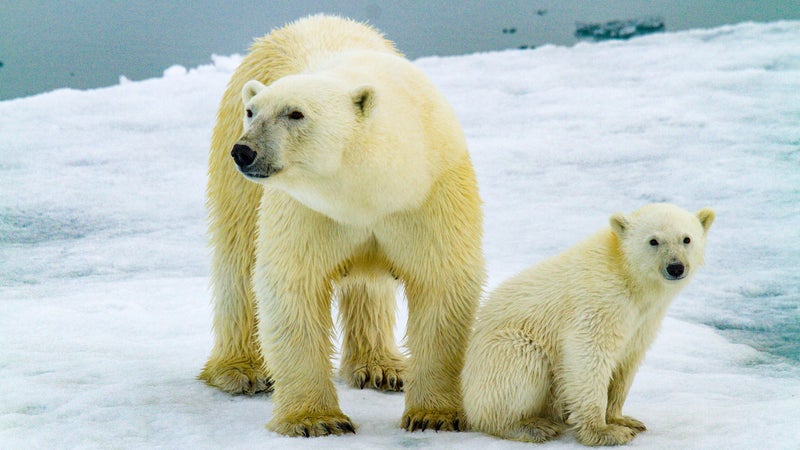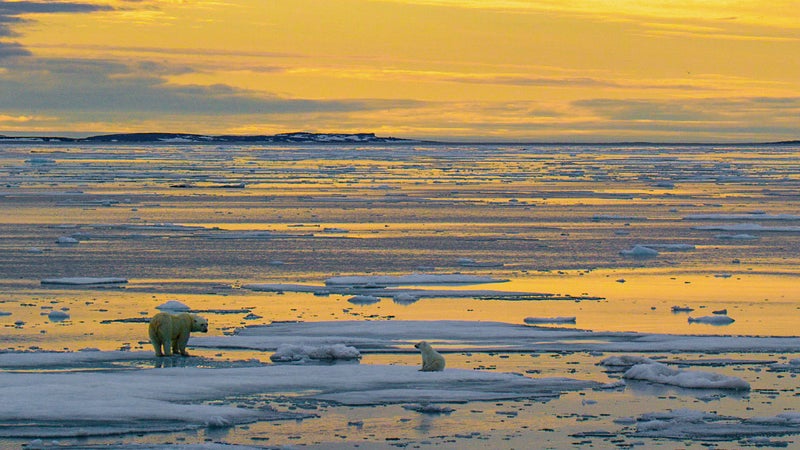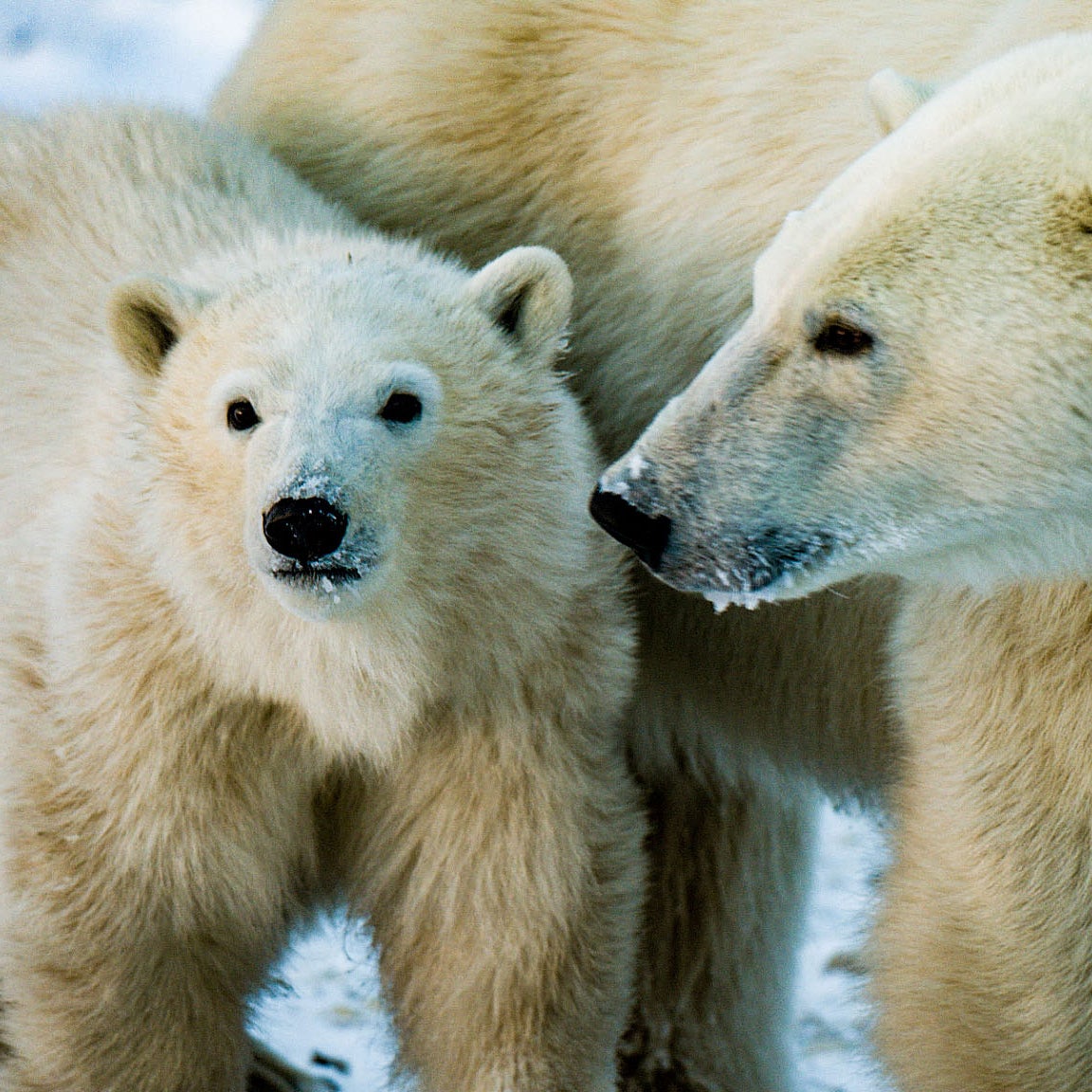On September 12, just hours after the Arctic National Wildlife Refuge (ANWR) from drilling, the Department of the Interior announced for oil and gas exploitation. Lease sales will take place before the end of 2019.
Efforts to circumvent and undermine┬áprotections for polar bears by administration officials┬ácan be traced back to at least 2008, all┬áin an effort to drill in our countryÔÇÖs last unspoiled wilderness.
How Drilling ANWR Threatens Polar Bears
Above is a map of polar bear denning sites in ANWR, compared to the area DOI plans to lease for oil and gas drilling. As you can see, the proposed drilling areas encompass known denning areas. These maps were .╠ř
According to , it intends to, ÔÇťlease the entire program area.ÔÇŁ┬á
Oil and gas exploration requires locating resource deposits and identifying drilling sites using . That process involves sending high pressure vibrations into the ground, at 135 foot intervals, across the entire region. To conduct that process, teams of 150 to 160 workers living in mobile camps must move heavy equipment over virtually every inch of the survey area using 90,000-pound trucks. And that process must occur in the winter, when the frozen ground can support the weight of those vehicles; the same time in which the bears are giving birth to cubs┬áand raising them in dens through the first three months of their lives.╠ř
The seismic surveys themselves are known to disturb the bears, as is the rest of the industrial activity required by the process. The trucks used are heavy enough that they can break through the snow,┬áand destroy polar bear dens.╠ř
ÔÇťEven if mother bears are able to escape being crushed as a vehicle drives over a den, it is highly unlikely that cubs could do so,ÔÇŁ reads┬áa study Polar Bears International (PBI) conducted on . It goes on to estimate a 25 percent chance that at least one polar bear will be crushed to death in one season of seismic surveys in ANWR.╠ř
The larger disturbance all that described activity will have on polar bear behavior is more widespread. The same PBI study explains that polar bear cubs are unable to survive outside of dens for the first three months of their lives, and that seismic survey activity can cause mothers to abandon their dens before that period is up, leaving cubs to die. Areas in which disturbance caused by the surveys is significant enough to disrupt denning bears encompass 97 percent of ANWRÔÇÖs coastal plain. ÔÇťIt is virtually certain that most undetected polar bears in their dens will be disturbed at some level,ÔÇŁ finds the study.╠ř
DOIÔÇÖs ANWR drilling plan does include . Aerial surveys will use┬áForward Looking Infrared Radar to try and identify den sites, and a one-mile exclusion zone will be created around those, in which no survey or drilling activity will be permitted.╠ř
To test the effectiveness of aerial FLIR surveys, PBI conducted multiple test flights over known denning sites, which were in heavy use by bears. This was a best-case scenario for the potential effectiveness of the aerial surveys, yet PBI was only able to detect known dens from the air 50 to 67 percent of the time, depending on the number of flights conducted. The study goes on to describe other limitations of aerial FLIR surveys: the arcticÔÇÖs frequently bad weather┬áand false positives created by other heat sources under the snow.╠ř
“To boost detections above 50 percent┬árequired monumental efforts including multiple flights and close adherence to identified ideal weather conditions,” elaborates Dr. Steven Amstrup, chief scientist for Polar Bears International, who conducted the surveys.╠ř“Whereas this was possible in a research setting where surveys were flown only over known points, it seems intractable when multiple searches would need to be focused on 3000 kilometers of denning habitat.”┬á┬á
So, given real world conditions, only 50┬ápercent of polar bear denning sites in ANWR would benefit from that one-mile exclusion zone. And, even those bears with protected dens would still end up impacted by other factors as drilling in the refuge progresses. Infrastructure like roads and pipelines would create barriers bears would need to cross between sea ice and denning sites.╠řIncreased human activity in the area would put bears at risk from vehicle traffic and human-bear conflict. Oil spills and other major pollution events that could conceivably result from oil and gas exploitation in the area could also .╠ř
“Poor cub survival in recent years indicates that females leaving their dens are increasingly in poor physical condition and need to get out to the ice and hunt as quickly as possible,” says Amstrup.╠ř“The impact of numerous potential barriers or sources of interference with direct passage to the ice can only be worse for already stressed family groups.”┬á┬á

Why ANWRÔÇÖs Bears Matter
Polar bears that den in ANWR are part of the Southern Beaufort Sea (SBS) populationÔÇöone of 19 total populations in the arctic, and one of only two populations found in the United States. Between 2001 and 2010, the loss of sea ice due to climate change caused the SBS population to plummet . The last known count for the SBS population was just 900.╠ř
Cub survival is already at perilously low rates within this population. During a 2004 to 2006 study period, the SBS population was afflicted by a zero percent cub survival rate. That has since improved, but still stands at half the historic rate. PBI estimates that the number of year-old bears in the SBS population could be as low as 54.
ÔÇťNegative impacts on denning could accelerate the ongoing declining trend in the SBS population and lower the probability that the SBS population can persist,ÔÇŁ writes Polar Bears International. . With the population so close to collapse, every bear there matters. And, PBI has identified that, as sea ice levels continue to fall due to climate change, more and more bears are denning on land. ANWR will only grow more important to the SBS population in the future.╠ř
CouldnÔÇÖt the bears just go elsewhere? ÔÇťANWR is the most important denning site in the United States for polar bears,ÔÇŁ explains Amstrup.╠řHe says that thereÔÇÖs just no where else as viable for the SBS population. “Piling more stresses onto an already stressed population can only exacerbate that populationÔÇÖs declining status,” he continues.
All this is a problem for the survival of the polar bear species as a whole. As I explored at length in this article, the polar bear is directly threatened by climate change. As sea ice in the arctic is lost, so too does the polar bear lose its hunting grounds. If the polar bear is to survive, we must tackle climate change. But┬áwe must also keep the species in the best health possible until climate change is addressed, if the bears are to stand a chance of recovery when that happens. The loss of one of only 19 total populations would be a devastating blow to that chance.╠ř

How This Happened
The Trump administration has had to overcome┬áor circumvent numerous protections for the polar bear in order to open up ANWRÔÇÖs fragile coastal plain for drilling.╠ř
Its first success came way back in 2008. Back then, current Secretary of the Interior David Bernhardt was working as the departmentÔÇÖs solicitor┬áand authored the ruling that listed the polar bear as threatened, rather than endangered. YouÔÇÖll find a further explanation of those shenanigans here. The short version is that by weaving a complicated legal argument, that the dots between emissions from a specific source of pollution and effects felt by a specific bear or population of bears couldnÔÇÖt be connected, he prevented a ruling that those emissions endangered the species.╠ř
That served as a proof of concept to changes Bernhardt made to the Endangered Species Act last month. In those, he also added language stating that, to be subject to ESA regulation, a project must impact the entirety of a speciesÔÇÖ habitat┬árather than just parts of it. And┬áhe changed the ESAÔÇÖs definition of ÔÇťforeseeable futureÔÇŁ to preclude the assessment of long term risks an endangered or threatened species might face.╠ř
You can see both those changes at play here. The impact rule opens up critical polar bear habitat for drilling, while the longterm damage that will occur to ANWR is no longer considered by the ESA.╠ř
Before the administration made those changes to the ESA through executive order, another undemocratic process was at work. In the fall of 2017, Alaska senator Lisa Murkowski added a rider to the GOPÔÇÖs signature overhaul of the federal tax code,┬ámandating that the government begin issuing oil and gas leases in ANWR. Because that bill was filibuster-proof, the rider guaranteed that drilling in ANWR would become law. Even some Republicans opposed it, with .
The next step was to create the Environmental Impact Statement dictated by the National Environmental Policy Act. Those mandate a public comment period┬áand are supposed to make the federal agency in question accountable to the public. But┬áthat public comment period for ANWR drilling was conducted during the prolonged government shutdown that ran from late 2018┬áinto early 2019. (It did eventually receive a one-month extension post-shutdown.)┬áMeetings with local communities were scheduled during the shutdown, but those rural, dispersed communities in northern Alaska were given minimal notice of the meetings, something DOI blamed on the shutdown. Those community members who did make it .╠ř
Still, public comments did result, and you can find . LetÔÇÖs look at one example:
ÔÇťStudies demonstrate that being forced to emerge from a den early can have significant survival impacts on cubs post emergence,ÔÇŁ writes one commenter, whose name is withheld. ÔÇťSuccessful emergence from dens does not mean that denning near development did not have an impact or cause early emergence resulting in reduced cub survival,ÔÇŁ they continue, referring to language in what was then merely a proposal that minimized the perceived impacts on polar bear denning sites.╠ř
ÔÇťText is accurate as written,ÔÇŁ writes DOI, in response. The EIS was completed, and now the only thing standing┬ábetween ANWRÔÇÖs polar bears and drilling is time.


